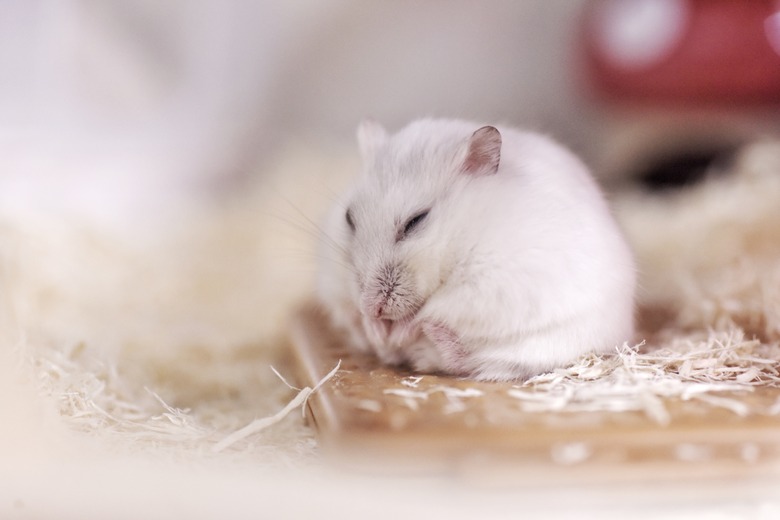About Albino Hamsters
Albinism is associated with the color white: white fur and white skin as well as pink eyes. However, not all white hamsters are albino hamsters. True albinism is associated with a specific gene, and animals with this gene are unable to make pigment in their skin, fur, or eyes because they lack an important enzyme called tyrosinase. Of all the hamster breeds, the only one capable of having this gene is the Campbell's dwarf hamster.
Therefore, only the white Campbell's dwarf hamster is a true albino dwarf hamster. They have white fur, pink ears, and pink eyes. It's possible to find a white dwarf hamster with red eyes that's a different breed, but it isn't an actual albino. Arguably, real albino dwarf hamsters are rare but indisputably cute.
Campbell’s albino dwarf hamster
Campbell's albino dwarf hamster
Campbell's dwarf hamsters, also known as Russian dwarf hamsters, are smaller than the common teddy bear hamster and are more sociable, so they're able to live in colonies. There are three main colors, including agouti, a grayish-brown; argente, a sandy cinnamon; and albino. Some albino hamsters might look white or be white-bellied thanks to a different gene. White-bellies are considered partial albinos.
However, only Campbell's dwarf hamsters carrying a specific gene are true albinos. No credible breeder would breed two albinos or white-bellies. If two white-bellies are mated, at least one quarter of the litter will be anopthalmic — born with no eyes or teeth. Anopthalmic albino dwarf hamsters are blind and also deaf. Their life span is not long.
Albino dwarf hamster health
Albino dwarf hamster health
Fortunately, there's no indication that having a single gene for albinism has any negative impact on a hamster's health. Campbell's albino dwarf hamsters are equally susceptible to common hamster illnesses and issues, such as overgrown teeth, cheek pouch disease, and wet tail. The latter is a deadly intestinal disease sometimes called proliferative ileitis, which is also a problem for rabbits.
White or albino hamsters' life span is improved in captivity because in the wild, their light color makes them easy prey. Their average life span in captivity is two years.
White dwarf hamsters
White dwarf hamsters
Not all white hamsters are albino. For instance, the winter white dwarf hamster, also called the Siberian or white Russian, are naturally white and have large black eyes. They also have smaller ears and thick fur thanks to origins tracing back to the cold climate of Siberia. The winter white is about 4 inches long and weighs .5 to 2 ounces. True to its name, the fur becomes its whitest during the winter months.
Other hamster breeds
Other hamster breeds
In addition to the Campbell's dwarf hamster and the winter white hamster, there are three other common pet hamster breeds. Syrian hamsters, also called teddy bear or golden hamsters, are the most common pets. At 7 inches when fully grown, Syrian hamsters are the easiest to handle, and they come in a variety of colors, including the classic golden and white. After 10 weeks old, they must live alone, or they might kill each other. Tiny black eyes and stubby pink tails are characteristic of this breed.
Roborovski dwarf hamsters are the smallest hamster breed and are more difficult to handle due to their size and agility. However, they are less likely to nip and can live in same sex pairs or groups. With a sandy brown and sometimes white stomach, Roborovski are only 1.5 to 2 inches long. They have the longest life span at three years. Most hamsters live about two years.
Chinese hamsters, also called striped hamsters, should live alone like Syrians. They are smaller at about 4 inches in length. Long and slender bodies give them a mouselike appearance. Like all hamsters, they are nocturnal, which means they are most active at night and sleep during the day.
